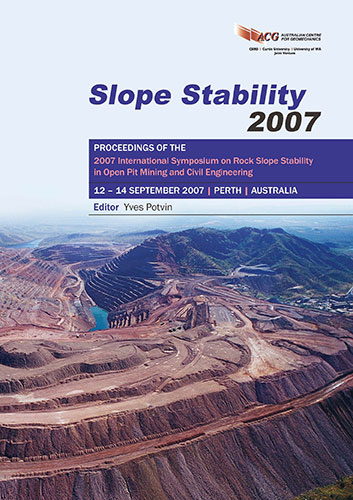Tarkwa Gold Mine, Ghana, West Africa - A Case Example of Upgrading the Reliability of Reserves by Improved Accounting for Structural Geology in Pit Designs

|
Authors: Avane, GB; Saayman, AF |
DOI https://doi.org/10.36487/ACG_repo/708_6
Cite As:
Avane, GB & Saayman, AF 2007, 'Tarkwa Gold Mine, Ghana, West Africa - A Case Example of Upgrading the Reliability of Reserves by Improved Accounting for Structural Geology in Pit Designs', in Y Potvin (ed.), Slope Stability 2007: Proceedings of the 2007 International Symposium on Rock Slope Stability in Open Pit Mining and Civil Engineering, Australian Centre for Geomechanics, Perth, pp. 117-128, https://doi.org/10.36487/ACG_repo/708_6
Abstract:
Structural geologic controls play major roles in the genesis and physical characteristics of Tarkwaian gold deposits in the Ashanti gold belt in Ghana. The Ashanti belt is a member of the extensively researched Eburnean orogenic event that metamorphosed, deformed, faulted and fractured the Birimian Super Group and the Tarkwaian Group rocks. This tectonic history determined the ultimate spatial distribution, size, geometry, physical characteristics and virgin stress regimes of the gold deposits exploited at Tarkwa Gold Mine. Structural geological controls are well understood and extensively used in exploration. Regrettably, geotechnical investigations often do not award due attention to structural geologic settings of deposits and to modelling major geologic structures, in order to identify and analyse potential failure mechanisms. This paper discusses redesign of the “Midlap & Underlap” pit as case example of structural oversight. Slope designs of the Tarkwa pits were based on the empirical Mining Rock Mass Ratings (MRMR) method, classical stereographic analysis, limit equilibrium analyses and numerical modelling using FLAC. Major structures were not explored and modelled in detail, consequently were inadequately accounted for in pit designs. Slope instability early in pit development and geotechnical reviews indicated high probability for major slope failures, in particular untenable risks of losing key ramps if the original mine plans were followed. Pit redesign and consequential changes to ore reserves emphasized the importance of basing geotechnical designs on methodical structural geologic modelling from the earliest studies. Ore reserve classifications should reflect the reliability of geotechnical models and resulting pit designs.
References:
Grififis, R.J., Barning, K., Agezo, F.L. and Akosa, F.K. (2002) Gold Deposits of Ghana, published by the Ghana
Minerals Commission.
Haines, A. (2002) Review of slope stability and associated mining geotechnical conditions at the Tarkwa Open Pit
Operation, Ghana, SRK Consulting report.
Karpeta, W.P. (2000) A review of the geology, mining and exploration of the Tarkwa Mine area. Harwood International
report.
Karpeta, W.P. (2001) The structural evolution of the Tarkwa basin in the Tarkwa mine area. Bastillion Limited report.
Saayman, A.F. (2005) 1st iteration Midlap & Underlap pit geotechnical redesign. Geotec-Africa report.
Tarkwa Gold Mine, Ghana, West Africa — A Case Example of Upgrading the Reliability of
Reserves by Improved Accounting for Structural Geology in Pit Designs G.B. Avane, A.F. Saayman
128 Slope Stability 2007, Perth, Australia
© Copyright 2025, Australian Centre for Geomechanics (ACG), The University of Western Australia. All rights reserved.
View copyright/legal information
Please direct any queries or error reports to repository-acg@uwa.edu.au
View copyright/legal information
Please direct any queries or error reports to repository-acg@uwa.edu.au